User:Vanished user 90345uifj983j4toi234k/World War II
| World War II sam | |||||||
|---|---|---|---|---|---|---|---|
| |||||||
| Belligerents | |||||||
|
and others | |||||||
| Casualties and losses | |||||||
|
Military dead: 17 million Civilian dead: 33 million Total dead: 50 million |
Military dead: 8 million Civilian dead: 4 million Total dead: 12 million | ||||||
World War II, also WWII, or the Second World War, was a global military conflict that took place between 1939 and 1945. It was the largest and deadliest war in history.
Even though
The
On
Italy surrendered in September 1943; Germany surrendered in May 1945. Following the atomic bombings of Hiroshima and Nagasaki, Japan surrendered, marking the end of the war on September 2, 1945.
It is possible that around 62 million people
After World War II,
Causes
Commonly held general causes for WWII are the rise of nationalism, the rise of militarism, and the presence of unresolved territorial issues. In Germany, resentment of the
Japan in the 1930s was ruled by a militarist clique devoted to becoming a world power.
Chronology
War breaks out in Europe: 1939
Pre-war alliances
After the collapse of the
Invasion of Poland
On September 1, Germany invaded Poland. Two days later, Britain and France declared war on Germany. The French mobilized slowly, then mounted only a token offensive in the Saar, which they soon abandoned, while the British could not take any direct action in support of the Poles in the time available (see Western betrayal). Meanwhile, on September 9, the Germans reached Warsaw, having slashed through the Polish defenses.
On
After Poland fell, Germany paused to regroup during the winter of 1939-1940 until April 1940, while the British and French stayed on the defensive. The period was referred to by journalists as "the
Battle of the Atlantic
Meanwhile in the North Atlantic, German
In the
War spreads: 1940
Soviet-Finnish War
The Soviet Union attacked Finland on
Invasion of Denmark and Norway

Germany invaded Denmark and Norway on April 9, 1940, in Operation Weserübung, in part to counter the threat of an impending Allied invasion of Norway. Denmark did not resist, but Norway fought back, and was joined by British, French, and Polish (exile) forces landing in support of the Norwegians at Namsos, Åndalsnes, and Narvik. By late June, the Allies were defeated, German forces were in control of most of Norway, and what remained of the Norwegian Army had surrendered.
Invasion of France and the Low Countries
On May 10, 1940, the Germans invaded Luxembourg, Belgium, the Netherlands, and France, ending the Phony War. The British Expeditionary Force (BEF) and the French Army advanced into northern Belgium and planned to fight a mobile war in the north while maintaining a static continuous front along the Maginot Line further south. The Allied plans were immediately smashed by the most classic example in history of Blitzkrieg.
In the first phase of the invasion, Fall Gelb (CACA), the Wehrmacht's Panzergruppe von Kleist raced through the
German forces then continued the conquest of France with Fall Rot (Case Red), advancing behind the Maginot Line and near the coast. France signed an armistice with Germany on June 22 1940, leading to the establishment of the Vichy France puppet government in the unoccupied part of France.
Battle of Britain
Following the defeat of France, Britain chose to fight on, so Germany began preparations in summer of 1940 to invade Britain in
North African Campaign
The Italian declaration of war in June 1940 challenged the British supremacy of the Mediterranean, hinged on
Invasion of Greece
after the Greek Premier John Metaxas rejected an ultimatum to hand over Greek territory. Despite the enormous superiority of the Italian forces, the Greek army forced the Italians into a massive retreat deep into Albania. By mid-December, the Greeks occupied one-fourth of Albania. The Greek army had inflicted upon the Axis Powers their first defeat in the war, and Nazi Germany would soon be forced to intervene.War becomes global: 1941
European Theatre
- Lend-Lease
U.S. President Franklin D. Roosevelt signed the Lend-Lease Act on March 11. This program was the first large step away from American isolationism, providing for substantial assistance to the U.K., the Soviet Union, and other countries.
- Invasion of Greece and Yugoslavia
- Invasion of Soviet Union

On June 22, 1941, Operation Barbarossa, the largest invasion in history, began. Three German army groups, an Axis force of over four million men, advanced rapidly deep into the Soviet Union, destroying almost the entire western Soviet army in huge battles of encirclement. The Soviets dismantled as much industry as possible ahead of the advancing Axis forces, moving it to the Ural Mountains for reassembly.
By late November, the Axis had reached a line at the gates of Leningrad, Moscow, and Rostov, at the cost of about 23 percent casualties. Their advance then ground to a halt. The German General Staff had underestimated the size of the Soviet army and its ability to draft new troops.
They were now dismayed by the presence of new forces, including fresh Siberian troops under General
German forward units had advanced within distant sight of the golden onion domes of Moscow's Saint Basil's Cathedral, but then on December 5, the Soviets counter-attacked and pushed the Axis back some 150-250 kilometers (100-150 mi), which became the first major German defeat of World War II.
Meanwhile, on June 25, the Continuation War between Finland and the Soviet Union began with Soviet air attacks shortly after the beginning of Operation Barbarossa.
- Allied conferences
The Atlantic Charter was issued as a joint declaration by Winston Churchill and President Roosevelt, at Argentia, Newfoundland, on August 14, 1941.
In late December 1941, Churchill met with Roosevelt again at the
- Mediterranean

In North Africa, Rommel's forces advanced rapidly eastward, laying siege to the vital seaport of Tobruk. Two Allied attempts to relieve Tobruk were defeated, but a larger offensive at the end of the year (Operation Crusader) drove Rommel back after heavy fighting.
On May 20, the Battle of Crete began when elite German parachute and glider-borne mountain troops launched a massive airborne invasion of the Greek island. Crete was defended by Greek, New Zealand, Australia and British troops. The Germans attacked the island simultaneously on the three airfields.
Their invasion on two of the airfields failed, but they successfully captured one, which allowed them to reinforce their position and capture the island in a little over one week.
On May 24, the German battleship Bismarck sunk the battlecruiser HMS Hood in the Battle of the Denmark Strait. On May 27, Bismarck was herself sunk by the Royal Navy.
In June 1941, Allied forces invaded
Pacific Theatre
- Sino-Japanese war


A war had begun in East Asia before World War II started in Europe. On
- Japan and United States enter the War
In the summer of 1941, the United States began an oil embargo against Japan, which was a protest of Japan's incursion into French Indo-China and the continued invasion of China. Japan planned an attack on Pearl Harbor to cripple the U.S. Pacific Fleet before consolidating oil fields in the Dutch East Indies. On December 7, a Japanese carrier fleet launched a surprise air attack on Pearl Harbor, Hawaii. The raid resulted in two U.S. battleships sunk, and six damaged but later repaired and returned to service. The raid failed to find any aircraft carriers and did not damage Pearl Harbor's usefulness as a naval base. The attack strongly united public opinion in the United States against Japan. The following day, December 8, the United States declared war on Japan. On the same day, China officially declared war against Japan. Germany declared war on the United States on December 11, even though it was not obliged to do so under the Tripartite Pact. Hitler hoped that Japan would support Germany by attacking the Soviet Union. Japan did not oblige, and this diplomatic move by Hitler proved a catastrophic blunder which unified the American public's support for the war.
- Japanese offensive
Japan soon invaded the Philippines and the British colonies of
Deadlock: 1942
European Theatre
- Western and Central Europe
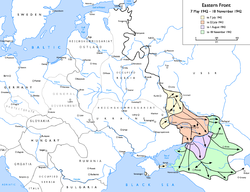

In May, top Nazi leader
On August 19, British and Canadian forces launched the
- Soviet winter and early spring offensives
In the north, Soviets launched the
In the south, Soviet forces launched an offensive in May against the German Sixth Army, initiating a bloody 17 day battle around Kharkov which resulted in the loss of over 200,000 Red Army personnel.
- Axis summer offensive
On June 28, the Axis began their summer offensive. German Army Group B planned to capture the city of Stalingrad which would secure the German left while Army Group A planned to capture the southern oil fields. In the Battle of the Caucasus, fought in the late summer and fall of 1942, the Axis forces captured the oil fields.
- Stalingrad
After bitter street fighting which lasted for a couple of months, the Germans captured 90% of Stalingrad by November. The Soviets, however, had been building up massive forces on the flanks of Stalingrad. They launched
In December German relief forces got within 50 kilometers (30 mi) of the trapped Sixth Army before they were turned back by the Soviets. By the end of the year, Sixth Army was in desperate condition, as the Luftwaffe was only able to supply about a sixth of the supplies needed.
- Eastern North Africa
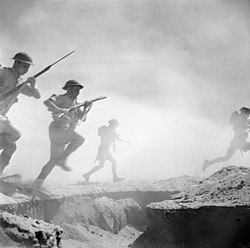
At the beginning of 1942, the Allied forces in North Africa were weakened by detachments to the Far East. Rommel once again attacked and recaptured Benghazi. Then he defeated the Allies at the Battle of Gazala, and captured Tobruk with several thousand prisoners and large quantities of supplies. Following up, he drove deep into Egypt but with overstretched forces.
The
Western North Africa
Pacific Theatre
Central and South West Pacific

On
In April, the Doolittle Raid, the first U.S. air raid on Tokyo, boosted morale in the U.S. and caused Japan to shift resources to homeland defence, but did little actual damage.
In early May, a Japanese naval invasion of Port Moresby, New Guinea, was thwarted by Allied navies in the Battle of the Coral Sea. This was both the first successful opposition to a Japanese attack and the first battle fought between aircraft carriers.
A month later, on June 5, American carrier-based dive-bombers sank four of Japan's best aircraft carriers in the Battle of Midway. Historians mark this battle as a turning point and the end of Japanese expansion in the Pacific. Cryptography played an important part in the battle, as the United States had broken the Japanese naval codes and knew the Japanese plan of attack.
In July, a Japanese
On
In late August and early September, while battle raged on Guadalcanal, an amphibious Japanese attack on the eastern tip of New Guinea was met by Australian forces in the Battle of Milne Bay.
Sino-Japanese War
Japan launched a major offensive in China following the attack on Pearl Harbor. The aim of the offensive was to take the strategically important city of Changsha which the Japanese had failed to capture on two previous occasions. For the attack, the Japanese massed 120,000 soldiers under 4 divisions. The Chinese responded with 300,000 men, and soon the Japanese army was encircled and had to retreat.
War turns: 1943
European Theatre
German and Soviet spring offensives

After the surrender of the German Sixth Army at Stalingrad on
German summer offensive
On July 4, the Wehrmacht launched a much-delayed offensive against the Soviet Union at the Kursk salient. Their intentions were known by the Soviets, and they hastened to defend the salient with an enormous system of earthwork defenses. Both sides massed their armor for what became a decisive military engagement. The Germans attacked from both the north and south of the salient and hoped to meet in the middle, cutting off the salient and trapping 60 Soviet divisions. The German offensive was ground down as little progress was made through the Soviet defenses. The Soviets then brought up their reserves, and the largest tank battle of the war occurred near the city of Prokhorovka. The Germans had exhausted their armored forces and could not stop the Soviet counter-offensive that threw them back across their starting positions.
Soviet fall and winter offensives
In August, Hitler agreed to a general withdrawal to the Dnieper line, and as September proceeded into October, the Germans found the Dnieper line impossible to hold as the Soviet bridgeheads grew. Important Dnieper towns started to fall, with Zaporozhye the first to go, followed by Dnepropetrovsk.
Early in November the Soviets broke out of their bridgeheads on either side of Kiev and recaptured the Ukrainian capital.
First Ukrainian Front attacked at Korosten on Christmas Eve. The Soviet advance continued along the railway line until the 1939 Polish-Soviet border was reached.
Italy
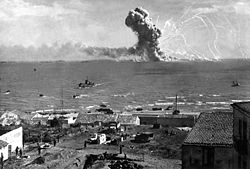
The surrender of Axis forces in Tunisia on May 13, 1943 yielded some 250,000 prisoners. The North African war proved to be a disaster for Italy, and when the Allies invaded Sicily on July 10 in Operation Husky, capturing the island in a little over a month, the regime of Benito Mussolini collapsed. On July 25, he was removed from office by the King of Italy, and arrested with the positive consent of the Great Fascist Council. A new government, led by Pietro Badoglio, took power but declared that Italy would stay in the war. Badoglio actually had begun secret peace negotiations with the Allies.
The Allies
In the north, the Nazis let Mussolini create what was effectively a puppet state, the Italian Social Republic or "Republic of Salò", named after the new capital of Salò on Lake Garda .
Mid-1943 brought the fifth and final German
Pacific Theatre
Central and South West Pacific


On
American authorities declared Guadalcanal secure on February 9. Australian and U.S. forces undertook the prolonged campaign to retake the occupied parts of the Solomon Islands, New Guinea and the Dutch East Indies, experiencing some of the toughest resistance of the war. The rest of the Solomon Islands were retaken in 1943.
In November,
Sino-Japanese War
A vigorous, fluctuating battle for Changde in China's Hunan province began on November 2, 1943. The Japanese threw over 100,000 men into the attack on the city, which changed hands several times in a few days but ended up still held by the Chinese. Overall, the Chinese ground forces were compelled to fight a war of defense and attrition while they built up their armies and awaited an Allied counteroffensive.
South East Asia
The Nationalist
Beginning of end: 1944
European Theatre
Soviet winter and spring offensives
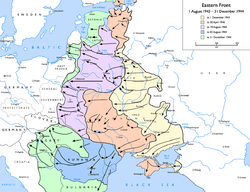
In the north, a Soviet offensive in January 1944 had relieved the siege of Leningrad. The Germans conducted an orderly retreat from the Leningrad area to a shorter line based on the lakes to the south.
In the south, in March, two Soviet fronts encircled Generaloberst
In early May, the Red Army's 3rd Ukrainian Front engaged German Seventeenth Army of Army Group South which had been left behind after the German retreat from the Ukraine. The battle was a complete victory for the Red Army, and a botched evacuation effort across the Black Sea led to over 250,000 German and Romanian casualties.
During April 1944, a series of attacks by the Red Army near the city of Iaşi, Romania aimed at capturing the strategically important sector. The German-Romanian forces successfully defended the sector throughout the month of April. The attack at Târgul Frumos was the final attempt by the Red Army to achieve its goal of having a spring-board into Romania for a summer offensive.
With Soviet forces approaching, German troops occupied Hungary on March 20. Hitler thought that Hungarian leader Admiral Miklós Horthy might no longer be a reliable ally.
Finland sought a separate peace with Stalin in February 1944, but the terms offered were unacceptable. On
Italy and the Balkans

During the winter the Allies tried to force the Gustav line on the southern
The road to Rome was blocked by the Gustav line, and the Germans made their stand at
Only after some months, the Gustav line was broken and the Allies marched towards the north of the peninsula. On June 4, Rome fell to Allies, and the Allied army reached Florence in August. They then stopped along the Gothic Line on the Tuscan Apennines during the winter.
Germany withdrew from the Balkans and held Hungary until February 1945.
Romania turned against Germany in August 1944, and Bulgaria surrendered in September.
Soviet summer offensive
Operation Bagration, a Soviet offensive involving 2.5 million men and 6,000 tanks, was launched on June 22. Its objective was to clear German troops from Belarus. The subsequent battle resulted in the destruction of German Army Group Centre and over 800,000 German casualties, the greatest defeat for the Wehrmacht during the war. The Soviets swept forward, reaching the outskirts of Warsaw on July 31.
Soviet fall and winter offensives
After the destruction of Army Group Center, the Soviets attacked German forces in the south in mid-July 1944, and in a month's time they cleared the Ukraine of German presence.
The Red Army's 2nd and 3rd Ukrainian Fronts engaged German Heeresgruppe Südukraine, which consisted of German and Romanian formations, in an operation to occupy Romania and destroy the German formations in the sector. The result of the battle was complete victory for the Red Army and a switch of Romania from the Axis to the Allied camp.
In October 1944, General der Artillerie Maximilian Fretter-Pico's Sixth Army encircled and destroyed three corps of Marshal Rodion Yakovlevich Malinovsky's Group Pliyev near Debrecen, Hungary. This was to be the last German victory in the Eastern front.
The Red Army's 1st, 2nd, and 3rd Baltic Fronts engaged German Army Group Centre and Army Group North to capture the Baltic region from the Germans. The result of the series of battles was a permanent loss of contact between Army Groups North and Centre, and the creation of the Courland Pocket in Latvia.
From December 29, 1944 to February 13, 1945, Soviet forces laid siege to Budapest, which was defended by German Waffen-SS and Hungarian forces. It was one of the bloodiest sieges of the war.
Warsaw Uprising


The proximity of the Red Army led the Poles in Warsaw to believe they would soon be liberated. On August 1, they revolted as part of the wider Operation Tempest. Nearly 40,000 Polish resistance fighters seized control of the city. The Soviets, however, stopped outside the city and gave the Poles no assistance as German army units moved into the city to put down the revolt. The resistance ended on October 2. German units then destroyed most of what was left of the city.
Allied invasion of Western Europe
Operation Market Garden
Allied paratroopers attempted a fast advance into the Netherlands with
German winter offensive
In December 1944, the German Army made its last major offensive in the West, known as the
Pacific Theatre
Central and South West Pacific
The American advance continued in the southwest Pacific with the capture of the
The main objective was the Mariana Islands, especially Saipan and to a lesser extent, Guam. The Japanese in both places were strongly entrenched. On June 11, Saipan was bombarded from the sea and a landing was made four days later; it was captured by July 9. The Japanese committed much of their declining naval strength in the Battle of the Philippine Sea but suffered severe losses in both ships and aircraft. After the battle, the Japanese aircraft carrier force was no longer militarily effective. With the capture of Saipan, Japan was finally within range of B-29 bombers.
Guam was invaded on July 21 and taken on August 10, but the Japanese fought fanatically. Mopping up operations continued long after the Battle of Guam was officially over. The island of Tinian was invaded on July 24 and was conquered on August 1. This was the first use of napalm in the war.
General MacArthur's troops invaded the Philippines, landing on the island of Leyte on October 20. The Japanese had prepared a rigorous defense and used the last of their naval forces in an attempt to destroy the invasion force in the Battle of Leyte Gulf, October 23 through October 26, 1944, arguably the largest naval battle in history. This was the first battle that had kamikaze attacks.
Throughout 1944, American submarines and aircraft attacked Japanese merchant shipping and deprived Japan's industry of the raw materials it had gone to war to obtain. The effectiveness of this stranglehold increased as U.S. Marines captured islands closer to the Japanese mainland. In 1944, submarines sank three million tons of cargo, while the Japanese were only able to replace less than one million tons.
Sino-Japanese War

In April 1944, the Japanese launched Operation Ichigo. The aim was to secure the railway route across Japanese occupied territories of northeast China, Korea, and South East Asia, and to destroy airbases in the area which serviced United States Army Aircraft Forces (USAAF) aircraft. In June 1944, the Japanese deployed 360,000 troops to invade Changsha for the fourth time. The operation involved more Japanese troops than any other campaign in the Sino-Japanese war, and after 47 days of bitter fighting, the city was taken, but at a very high cost. By November, the Japanese had taken the cities of Guilin and Liuzhou which served as USAAF airbases from which it conducted bombing raids on Japan. However, despite having destroyed the airbases in this region, the USAAF could still strike at the Japanese main islands from newly acquired bases in the Pacific. By December, the Japanese forces reached French Indochina and achieved the purpose of the operation, but only after incurring heavy losses.
South East Asia
In March 1944, the Japanese began their "march to Delhi" by crossing the border from Burma into India. On March 30, they attacked the town of Imphal which involved some of the most ferocious fighting of the war. The Japanese soon ran out of supplies and withdrew resulting in a loss of 85,000 men, one of the largest Japanese defeats of the war. The Anglo-Indian forces were constantly re-supplied by the RAF.
End of war: 1945
European Theatre
Soviet winter offensive

On January 12, the Red Army was ready for its next big offensive. Konev's armies attacked the Germans in southern Poland and expanded out from their Vistula River bridgehead near Sandomierz. On January 14, Rokossovsky's armies attacked from the Narew River north of Warsaw. They broke the defences covering East Prussia. Zhukov's armies in the centre attacked from their bridgeheads near Warsaw. The German front was now in shambles.
On
Yalta Conference
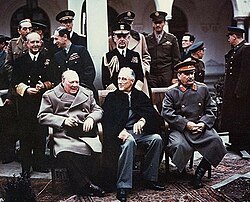
Meanwhile, Churchill, Stalin, and Roosevelt made arrangements for post-war Europe at the Yalta Conference in February 1945. Their meeting resulted in many important resolutions:
- An April meeting would be held to form the United Nations;
- Poland would have free elections (though in fact they were heavily rigged by Soviets);
- Soviet nationals were to be repatriated;
- The Soviet Union was to attack Japan within three months of Germany's surrender.
Soviet spring offensive
The Red Army (including 78,556 soldiers of the
By April 24, the three Soviet Army groups had completed the encirclement of the city. Hitler had sent the main German forces which were supposed to defend the city to the south. He believed that was the region where the Soviets would launch their spring offensive and not in Berlin. As a final resistance effort, Hitler called for civilians, including teenagers, to fight the oncoming Red Army in the Volkssturm militia. Those forces were augmented by the battered German remnants that had fought the Soviets in Seelow Heights. But even then the fighting was heavy, with house-to-house and hand-to-hand combat. The Soviets sustained 305,000 dead; the Germans sustained as many as 325,000, including civilians. Hitler and his staff moved into the Führerbunker, a concrete bunker beneath the Chancellery, where on April 30 1945, he committed suicide, along with his bride, Eva Braun.
Western Europe
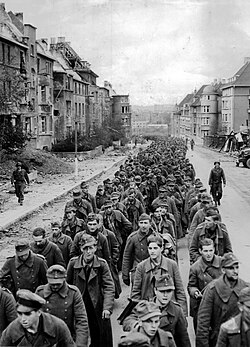
The Allies resumed their advance into Germany once the Battle of the Bulge officially ended on January 27, 1945. The final obstacle to the Allies was the river Rhine which was crossed in late March 1945.
Once the Allies had crossed the Rhine, the British fanned out northeast towards Hamburg crossing the river
Italy
Allied advances in the winter of 1944-45 up the Italian peninsula had been slow because of troop re-deployments to France. But by
A few days before the surrender of German troops in Italy, Italian partisans intercepted a party of
Germany surrenders
Admiral Karl Dönitz became leader of the German government after the death of Hitler, but the German war effort quickly disintegrated. German forces in Berlin surrendered the city to the Soviet troops on May 2, 1945.
The German forces in Italy surrendered on May 2, 1945, at General Alexander's headquarters, and German forces in northern Germany, Denmark, and the Netherlands surrendered on May 4. The German High Command under Generaloberst Alfred Jodl surrendered unconditionally all remaining German forces on May 7 in Reims, France. The western Allies celebrated "V-E Day" on May 8.
The Soviet Union celebrated "
Potsdam
The last Allied conference of World War II was held at the suburb of Potsdam, outside Berlin, from July 17 to August 2. During the Potsdam Conference, agreements were reached between the Allies on policies for occupied Germany. An ultimatum was issued calling for the unconditional surrender of Japan.
Pacific Theatre
Central and South West Pacific
In January, the U.S. Sixth Army landed on Luzon, the main island of the Philippines. Manila was re-captured by March. U.S. capture of islands such as
The last major offensive in the
South East Asia

In
Atomic bombings of Hiroshima and Nagasaki
The U.S. military and political chiefs had decided to use their new super-weapon to bring the war to a speedy end. The battle for Okinawa had shown that an invasion of the Japanese mainland (planned for November), seen as an Okinawa-type operation on a far larger scale, would result in more casualties than the United States had suffered so far in all theatres since the war began.
On
Soviet invasion of Manchuria
On August 8, two days after the atomic bomb was dropped on Hiroshima, the Soviet Union, having renounced its nonaggression pact with Japan, attacked the Japanese in Manchuria, fulfilling its Yalta pledge to attack the Japanese within three months after the end of the war in Europe. The attack was made by three Soviet army groups. In less than two weeks, the Japanese army in Manchuria consisting of over a million men had been destroyed by the Soviets. The Red Army moved into North Korea on August 18. Korea was subsequently divided at the 38th parallel into Soviet and U.S. zones.
Japan Surrenders
The American use of atomic weapons against Japan prompted Hirohito to bypass the existing government and intervene to end the war. The entry of the Soviet Union into the war may have also played a part, but in his radio address to the nation, Emperor Hirohito did not mention it as a major reason for his country's surrender.
The Japanese surrendered on August 15, 1945 (V-J day), signing the Japanese Instrument of Surrender on September 2, 1945, aboard the USS Missouri (BB-63) anchored in Tokyo Bay. The Japanese troops in China formally surrendered to the Chinese on September 9, 1945. This did not fully end the war, however, as Japan and the Soviet Union never signed a peace agreement. In the last days of the war, the Soviet Union occupied the southern Kuril Islands, an area claimed by the Soviets and still contested by Japan (see Kuril Islands dispute).
Aftermath

Europe in ruins
At the end of the war, millions of refugees were homeless, the European economy had collapsed, and 70% of the European industrial infrastructure was destroyed.
Partitioning of Germany and Austria
Germany was partitioned into four zones of occupation. An Allied Control Council was created to coordinate the zones. The original divide of Germany was between America, Soviet Union and Britain. Stalin agreed to give France a zone but it had to come from the American or British zones and not the Soviet zone. The American, British, and French zones joined in 1949 as the Federal Republic of Germany and the Soviet zone became the German Democratic Republic.
Austria was once again separated from Germany and it, too, was divided into four zones of occupation, which eventually reunited and became the Republic of Austria.
Reparations
Germany paid reparations to France, Britain and Russia, in the form of dismantled factories, forced labour, and shipments of coal. The U.S. settled for confiscating German patents and German owned property in the U.S., mainly subsidiaries of German companies.
In accordance with the Paris Peace Treaties, 1947, payment of war reparations was assessed from the countries of Italy, Romania, Hungary, Bulgaria, and Finland.
Morgenthau Plan
The initial occupation plans proposed by the United States were harsh. The Morgenthau Plan of 1944 called for dividing Germany into two independent nations and stripping it of the industrial resources required for war. All heavy industry was to be dismantled or destroyed, and the main industrial areas (Upper
While the Morgenthau Plan itself was never implemented per se, its general economic philosophy did end up greatly influencing events. Most notable were the toned-down offshoots, including the
Marshall Plan
Germany had long been the industrial giant of Europe, and its poverty held back the general European recovery. The continued scarcity in Germany also led to considerable expenses for the occupying powers, which were obligated to make up the most important shortfalls.
In view of the continued poverty and famine in Europe, and with the onset of the Cold War, a change of policy was required. The most notable example of this change was a plan established by U.S. Secretary of State
Border revisions and population shifts
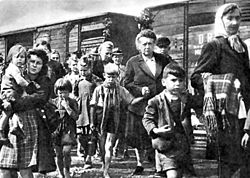
- Main article: Expulsion of Germans after World War II
As a result of the new borders drawn by the victorious nations, large populations suddenly found themselves in hostile territory. The main benefactor of these border revisions was the Soviet Union, which expanded its borders at the expense of Germany, Finland, Poland and Japan. Poland was compensated for its losses to the Soviet Union by receiving most of Germany east of the
The number of Germans expelled totaled roughly 15 million, including 11 million from Germany proper and 3.5 million from the Sudetenland.
Germany officially states that 2.1 million of these expelled lost their lives because of violence on the part of the Russians, Polish and Czech, though Polish and Czech historians dispute this figure.
Cold War begins

The end of World War II marked the end of the United Kingdom's position as a global superpower and the emergence of the United States and the Soviet Union as the dominant powers in the world. Friction had been building up between the two before the end of the war and after the collapse of Nazi Germany, relations spiraled downward.
In the areas occupied by Western Allied troops, pre-war governments were re-established or new democratic governments were created; in the areas occupied by Soviet troops, including the territories of former Allies such as Poland, communist states were created. These became satellites of the Soviet Union.
As the relationship between the victors deteriorated, the military lines of demarcation became the de facto country boundaries. Korea was divided in half along the 38th parallel by the Soviets and Americans. In 1950, communist North Korea, backed by the Soviets, invaded U.S.-supported South Korea and the Korean War broke out.
United Nations
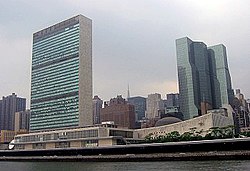
Because the League of Nations had failed to actively prevent the war, the United Nations was created in 1945.
The UN operates within the parameters of the
The UN also was responsible for the initial creation of the modern state of
Casualties, civilian impact, and atrocities
Casualties [[:Image:Leningraddiorama.gif|Diorama of the Siege of Leningrad. At least 641,000 Soviet citizens died during the 900 day siege.]]
Possibly 62 million people lost their lives in World War II—about 25 million soldiers and 37 million civilians, with estimates varying widely. This total includes the estimated 12 million lives lost in the Holocaust. Of the total deaths in World War II approximately 80% were on the Allied side and 20% on the Axis side.
Allied forces suffered approximately 17 million military deaths, of which about 10 million were Soviet and 4 million Chinese. Axis forces suffered about 8 million, of which more than 5 million were German. The Soviet Union suffered by far the largest death toll of any nation in the war; perhaps 23 million Soviets died in total, of which more than 12 million were civilians. The figures include deaths from internal Soviet actions against its own people. The statistics available for Soviet and Chinese casualties are only rough guesses since they are poorly documented. Some modern estimates double the amount of Chinese casualties.
Genocide
The Holocaust was the organized murder of at least nine million people, about two-thirds of whom were Jewish. Originally, the Nazis used killing squads,
Concentration camps, labour camps and internment
In addition to the Nazi
Furthermore, hundreds of thousands of
War crimes
From 1945 to 1951, German and Japanese officials and personnel were prosecuted for war crimes. Top German officials were tried at the
None of the alleged allied war crimes—such as the
Resistance and collaboration

Resistance during World War II occurred in every occupied country by a variety of means, ranging from non-cooperation, disinformation, and propaganda to outright warfare.
Among the most notable resistance movements were the
Before
Although Great Britain did not suffer invasion in World War II, the British made preparations for a British resistance movement, called the Auxiliary Units. Various organisations were also formed to establish foreign resistance cells or support existing resistance movements, like the British SOE and the American OSS.
The home fronts

"Home front" is the name given to the activities of the civilians of a nation that is in a state of total war.
In the United Kingdom, women joined the work force doing jobs that the men did. Food, clothing,
In the United States and Canada, women also joined the workforce. In the United States, these women were called "Rosies" for Rosie the Riveter. President Roosevelt stated that the efforts of civilians at home to support the war through personal sacrifice were as critical to winning the war as the efforts of the soldiers themselves. In Canada, the government established three military compartments for women: the Canadian Women's Auxiliary Air Force, Canadian Women's Army Corps and the Women's Royal Canadian Naval Services.
In Germany, until 1943 there were few restrictions on civilian activities. Most goods were freely available. This was because of the reduced access to certain luxuries already experienced by German civilians prior to the beginning of hostilities; the war served to make some commodities less available. It was not until comparatively late in the war that the civilian population was effectively organised to support the war effort. For example, women's labour was not mobilised as thoroughly as in the United Kingdom or the United States. Foreign slave labour substituted for the men who served in the armed forces.
American production was the major factor in keeping the Allies better supplied than the Axis. For example, in 1943 the United States produced 369 warships (1.01 per day). In comparison, Japan produced 122 warships, and Germany only built three. The United States also succeeded in rebuilding the Merchant Marine, reducing the build time of a Liberty or Victory ship from 105 days to 56 days. Much of this improved efficiency came from technological advances in shipbuilding. Hull plates were being welded rather than bolted, plastics were beginning to take the place of certain metals, and modular construction was being used.
Technologies

Weapons and technology improved rapidly during World War II and played a crucial role in determining the outcome of the war. Many major technologies were used for the first time, including nuclear weapons, radar, jet engines, and electronic computers. Enormous advances were made in aircraft, and tank design such that models coming into use at the beginning of the war were long obsolete by its end.
More new inventions, as measured in the U.S. by numbers of patent applications and weapon contracts issued to private contractors, were deployed to the task of killing humans more effectively (and to a lesser degree, avoiding being killed) than ever before.
The massive research and development demands of the war had a great impact on the growth of the scientific community. After the war ended, these developments led to new sciences like cybernetics and computer science and created entire new institutions of weapons design.
See also
References
- Second World War. Phoenix. 1995. ISBN 1857993462.
- The Second World War. Hutchinson. 1989. ISBN 0091740118.
- History of the Second World War. London: Cassell. 1970. ISBN 0304935646.
- A War to Be Won: Fighting the Second World War. )
- Why the Allies Won. Pimlico. 1995. ISBN 0712674535.
- Smith, J. Douglas and Richard Jensen (2003). World War II on the Web: A Guide to the Very Best Sites. ISBN 0842050205.
- A World at Arms: A Global History of World War II. ISBN 0521443172.
- Poteri narodonaseleniia v XX veke : spravochnik. 2004. ISBN 5931651071.
Footnotes
- ^ Overy, Richard
- ^ Erlikman, Vadim
- ^ Richard Overy The Dictators Hitler's Germany, Stalin's Russia p.568-569
External links
- General
- BBC History: World War Two
- Deutsche Welle special section on World War II created by one of Germany's public broadcasters on World War II and the world 60 years after.
- Directory of Online World War II Indexes & Records
- Halford Mackinder's Necessary War An essay describing the geopolitical aspects of World War II
- World War II Secret History
- World War II Military Situation Maps. Library of Congress
- Officially Declassified U.S. Government Documents about World War II
- Media
- US National Archives Photos
- Multimedia map - Presentation that covers the war from the invasion of Russia to the fall of Berlin
- Thousands of World War II Photographs & Movies
- Virtual Museum of World War II - pictures & info
- Stories
- WW2 People's War - A project by the BBC to gather the stories of ordinary people from World War II
- Memories of Leutnant d.R. Wilhelm Radkovsky 1940-1945 Experiences as a German soldier on the Eastern and Western Front
- Documentaries
- The World at War (1974) is a 36-part BBC series that covers most aspects of World War II from many points of view. It includes interviews with many key figures (Karl Dönitz, Albert Speer, Anthony Eden etc.) (Imdb link)
- The Second World War in Colour (1999) is a three episode documentary showing unique footage in color (Imdb link)
[[Category:World War II| ]]
{{Link FA|ar}}
{{Link FA|he}}
{{Link FA|no}}
{{Link FA|pt}}
{{Link FA|sv}}
{{Link FA|vi}}
{{Link FA|zh}}
[[af:Tweede Wêreldoorlog]]
[[als:Zweiter Weltkrieg]]
[[ang:Ōðru Woruldgūþ]]
[[ar:حرب عالمية ثانية]]
[[ast:Segunda Guerra Mundial]]
[[gn:Ñorairõ Guasu]]
[[ba:Икенсе донъя һуғышы]]
[[be:Другая сусьветная вайна]]
[[bs:Drugi svjetski rat]]
[[bg:Втора световна война]]
[[ca:Segona Guerra Mundial]]
[[cs:Druhá světová válka]]
[[cy:Yr Ail Ryfel Byd]]
[[da:2. verdenskrig]]
[[de:Zweiter Weltkrieg]]
[[et:Teine maailmasõda]]
[[el:Β΄ Παγκόσμιος Πόλεμος]]
[[es:Segunda Guerra Mundial]]
[[eo:Dua mondmilito]]
[[eu:Bigarren Mundu Gerra]]
[[fa:جنگ جهانی دوم]]
[[fr:Seconde Guerre mondiale]]
[[fy:Twadde Wrâldkriich]]
[[ga:An Dara Cogadh Domhanda]]
[[gl:Segunda Guerra Mundial]]
[[ko:제2차 세계 대전]]
[[hr:Drugi svjetski rat]]
[[io:Duesma mondo-milito]]
[[id:Perang Dunia II]]
[[is:Seinni heimsstyrjöldin]]
[[it:Seconda guerra mondiale]]
[[he:מלחמת העולם השנייה]]
[[ka:მეორე მსოფლიო ომი]]
[[sw:Vita Kuu ya Pili ya Dunia]]
[[la:Bellum Orbis Terrarum II]]
[[lv:Otrais pasaules karš]]
[[lb:Zweete Weltkrich]]
[[lt:Antrasis pasaulinis karas]]
[[li:Twiede Wereldoorlog]]
[[hu:II. világháború]]
[[mk:Втора Светска војна]]
[[mt:Tieni Gwerra Dinjija]]
[[ms:Perang Dunia II]]
[[nl:Tweede Wereldoorlog]]
[[ja:第二次世界大戦]]
[[no:Andre verdenskrig]]
[[nn:Andre verdskrigen]]
[[nds:Tweet Weltorlog]]
[[pl:II wojna światowa]]
[[pt:Segunda Guerra Mundial]]
[[ro:Al doilea război mondial]]
[[ru:Вторая мировая война]]
[[sq:Lufta e II-të Botrore]]
[[scn:Secunna guerra munniali]]
[[simple:World War II]]
[[sk:Druhá svetová vojna]]
[[sl:Druga svetovna vojna]]
[[sr:Други светски рат]]
[[sh:Drugi svetski rat]]
[[fi:Toinen maailmansota]]
[[sv:Andra världskriget]]
[[ta:இரண்டாம் உலகப் போர்]]
[[th:สงครามโลกครั้งที่สอง]]
[[vi:Đệ nhị thế chiến]]
[[tr:II. Dünya Savaşı]]
[[uk:Друга світова війна 1939-45]]
[[wa:Deujhinme guere daegnrece]]
[[zh-yue:第二次世界大戰]]
[[zh:第二次世界大战]]
